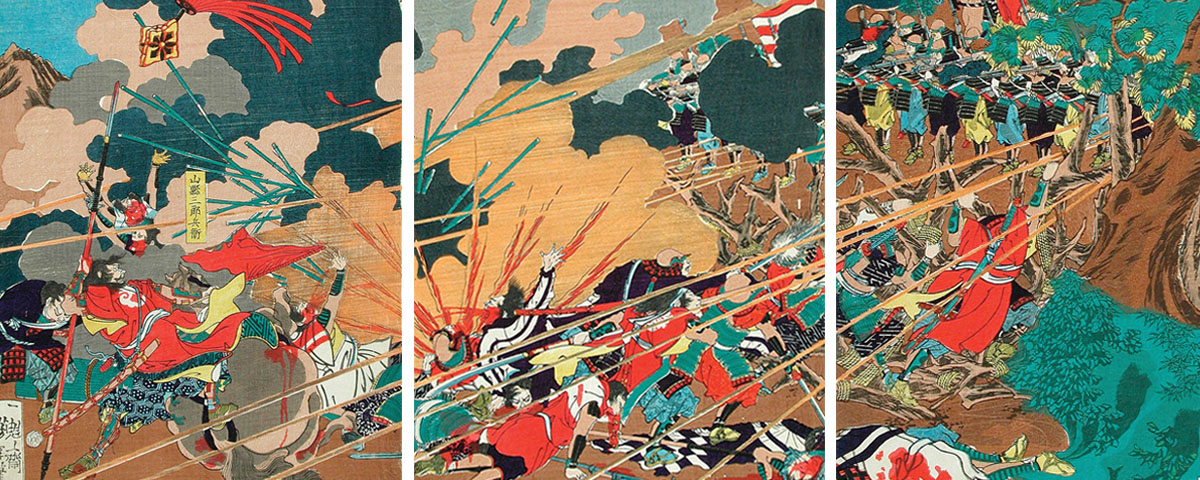On June 28, 1575, in central Honshu, Japan, warlord Nobunaga Oda led a force of 38,000 Oda and Tokugawa clan troops to break Katsuyori Takeda’s siege of Nagashino Castle, defended by Tokugawa warrior Sadamasa Okudaira. With his tactics Oda changed the face of Japanese warfare.
Head of the Takeda clan, known for its mounted samurai and fierce cavalry charges, Takeda had besieged the castle with 15,000 troops, one-third of whom were cavalrymen. The rest were lower-ranking foot soldiers (ashigaru), mostly armed with long spears, though some bore crude matchlock guns. (Portuguese traders had introduced firearms to Japan a few decades earlier.) Of the 38,000 men Oda fielded, about 3,000 were ashigaru armed with matchlocks.
When a scout alerted Takeda to the approaching relief force, his generals counseled the warlord to either withdraw or launch one last all-out attack on the castle. Were such an attack successful, they argued, the Takeda troops could then meet the larger relief force from behind the castle walls. Takeda instead sided with his younger generals, who urged him to meet Oda in open battle.
Oda, who had endured Takeda cavalry charges in the past, positioned his men across a plain from the castle, just behind the Rengogawa, a stream whose high banks would break up a cavalry charge. He also ordered construction of a wooden palisade, behind which he placed his matchlock gunners, given their vulnerability during long loading times. By dividing them into ranks, Oda ensured a steady volume of fire. He placed the 3,000 gunners under disciplined samurai officers—a revolutionary command decision, as high-ranking samurai seldom interacted with the lowly ashigaru. He also ordered gaps left in the palisade through which to mount counterattacks.
Takeda sent 12,000 of his 15,000-man force to face Oda’s force, retaining the remaining 3,000 to keep the castle garrison from sallying out in relief.
Believing an overnight rain had rendered Oda’s guns ineffective, Takeda quickly launched the anticipated cavalry charge. Restrained by their samurai officers, Oda’s matchlock gunners—who had kept their powder dry—held their fire as the Takeda cavalry charged across the plain. When the horsemen closed within 150 feet and slowed to cross the Rengogawa, Oda’s gunners fired in ranks, one shooting for every two reloading. His spearmen stabbed through the loose palisade at any enemy cavalry that made it past the initial volleys. Finally, Oda’s samurai fought man to man with any surviving Takeda warriors who penetrated the line. Concentrated forces at the ends of the palisade prevented any flanking.
The battle settled into an eight-hour grind before the Takeda force broke and fled with Oda’s men in pursuit. When it was over, Takeda had lost 10,000 men—fully one-third of the force he’d brought to the field.
Oda’s defeat of the formidable Takeda cavalry marked a sea change in Japanese warfare, in which rivals eschewed traditional cavalry matchups and melee infantry charges in favor of disciplined combat with firearms discharged from behind cover. MH
Overconfidence kills. Had Katsuyori Takeda heeded his experienced generals and withdrawn before the far larger enemy force, his army would have lived to fight another day.
Never assume—verify. Takeda had assumed rain had fouled Nobunaga Oda’s matchlocks—with disastrous results.
It’s not so much what you use as how you use it. Both sides had matchlock firearms, but Oda’s innovative use of a palisade and reliance on disciplined samurai officers made the difference.





